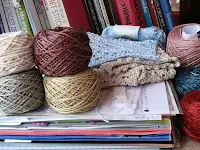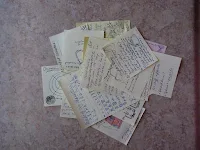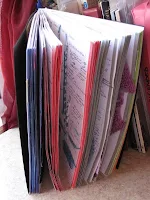
pictured: swatch of 5 heights of foundation stitches (no base chain used)
If you crochet with beads, you know there's a list of things to keep in mind:
- The beads tend to fall to the back of the crochet stitches
- The bead hole needs to be big enough for the crochet yarn/thread & needle
- The beads often need to be strung onto your yarn in a certain order before crocheting
- Non-round beads may settle into a crochet stitch at an unintended angle

- Line up alphabet beads just so (see 2nd photo)
- Make smiley beads look you straight in the eye, not tilt toward 3-o'clock or worse
- Have oval or tube-shaped beads lie horizontally instead of on a vertical angle
- Eliminate the need to crochet the first row of stitches into a foundation chain (something I've never enjoyed!)
- Are fabulous for fashion crochet because the starting edge of your garment is much more elastic (a big thank you to Doris Chan for teaching me this years ago)
- Result in a stronger, nicer cord (or purse strap, for ex.), of any desirable width, instead of plain chain stitches
- Are structured of vertical and horizontal strands that are easily beadable, unlike standard crochet stitches
 (3rd photo: "Lunar Window" designed for House of White Birches in 2005, using foundation stitches of varied heights exclusively)
(3rd photo: "Lunar Window" designed for House of White Birches in 2005, using foundation stitches of varied heights exclusively)If you've been following me in Twitter, you know that I recently made small items with my fourth grader that his classmates can purchase with school dollars at their "Mini-Mall" event.
We settled on a '70's hippie theme and so I brought out my stash of hemp cord, rainbow yarns, and hippie-looking beads (smileys, peace signs). My son's first thought was "headbands"! My first reaction was, "Sure! Quick and easy, if I use foundation crochet stitches."
I simply did 45 fsc with medium-weight yarn and an I (5.5mm) crochet hook, slip stitched the ends together, and added colored wood beads to the two yarn tails (no weaving in ends). See what I mean? Get out of here with that "work a row of single crochets into a foundation chain." So old school.
Now let's add tricky beads. I made beaded hemp bracelets for a few teachers (using shank buttons as beads). I had to string them on before crocheting so that they were all facing the same direction. As you can see in the photo, you wouldn't want a peace sign or smiley sideways or upside down; the sunglasses would have ended up sideways in a standard single crochet stitch.

Show Tricky Beads Who's Boss
Here's the step-by-step on how to crochet 'em in, using the actual bracelet pattern I created:
String 6 beads onto hemp string so that they face the same direction. String on a 7th larger bead to serve as a clasp button.
1. Chain 1, slide large bead up close to hook, chain 1 (1 beaded chain made), insert hook in 1st chain made, yarn over and pull up a loop, ch 1 leaving 1 loop still on hook (this becomes the "foundation chain" of the next sc you'll make; pinch it with your fingers or place a stitch marker there), yarn over, pull loop through both loops on hook (single crochet made).
2. Insert hook in the next marked (or pinched) stitch, yarn over and pull up a loop, chain 1 leaving 1 loop still on hook, mark it, yarn over and pull through both loops on hook. You have now made 2 fsc.
Notice that when you make each fsc, first you make a chain and the 3 yarn strands of the chain will run horizontally along the row of fsc when you're done. When when you complete the single crochet part of the fsc, two roughly vertical strands, which are often called the two "legs" of a crochet stitch, can be seen on the front side of the stitch. Also created are two horizontal strands that are found at the top edge of every kind of crochet stitch. It is difficult and sometimes impossible to place beads on the top two horizontal strands, but you can easily place beads on a leg of any crochet stitch (they end up on the back). With a fsc, you can also easily add beads to the horizontal strand running under the stitch legs.
3. To bead a leg of the next fsc: Pull up a loop in the next marked stitch, chain 1 and mark it, slide up a bead close to the hook, yarn over and pull through both loops on hook. You have now made 3 fsc.

4. Work another plain fsc like in step 2.
5. To bead a lower horizontal strand (the chain part) of a fsc: Pull up a loop in the next marked stitch, slide up a bead close to the hook, chain 1 to make a beaded chain, mark it, yarn over and pull through all loops on hook. You now have 5 fsc.
In 5th photo, only the "u" alphabet bead on the far left is readable. That one is on the lower horizontal strand of the chain part of the stitch. The other 2 beads are on the back "legs" of the stitches.
6. Continue working a plain fsc, then a beaded fsc, until you've used all strung beads.
7. Work 2 plain fsc.

8. To make a buttonhole for clasp, chain 2 then work a fdc, ready? yarn over, insert hook in marked stitch of last fsc, pull up loop, chain 1 leaving 3 loops on hook, yarn over, pull through 2 loops on hook, yarn over, pull through last 2 loops on hook. Fasten off. Add small wooden beads to each yarn tail. (Last photo shows only 5 small beads; I think 6 is better)
I'll be uploading more photos to the ToyDesigningVashti blog and creating some Ravelry pages for these free crochet patterns.























 I hope all of my readers enjoy crocheting this draft snake as much as I did. If you're wondering what to do with leftover crochet yarns or single skeins of pretties, this is your lucky day. This free 'n' easy pattern uses basic crochet stitches, yarns you already own, and is
I hope all of my readers enjoy crocheting this draft snake as much as I did. If you're wondering what to do with leftover crochet yarns or single skeins of pretties, this is your lucky day. This free 'n' easy pattern uses basic crochet stitches, yarns you already own, and is 





















